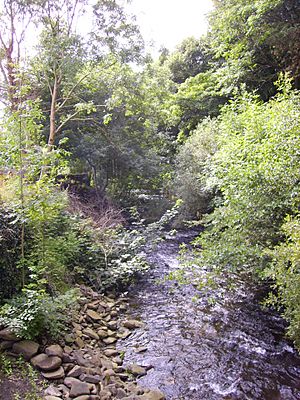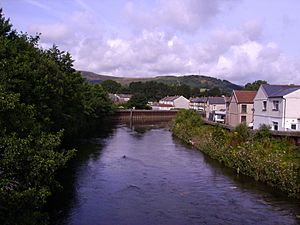River Rhondda facts for kids
The River Rhondda (called Afon Rhondda in Welsh) is an important river in South Wales. It has two main branches, or tributaries, called Rhondda Fawr (which means 'Big Rhondda') and Rhondda Fach (meaning 'Little Rhondda').
Contents
What is the River Rhondda Like?
The River Rhondda has two main parts: the Rhondda Fawr and the Rhondda Fach. Even though their names mean "big" and "little," both parts are actually about the same length.
How the Valleys Were Formed
Both valleys have a special U-shape. This shape was created by glaciers during many ice ages long ago. The glaciers slowly carved out the land, making the valleys deep.
The valleys cut through thick layers of rock called "Coal Measures." These layers are made of sandstones, mudstones, and important coal seams. These rocks formed millions of years ago during a time called the Carboniferous period.
The Impact of Coal Mining
For a long time, coal mining was very important in the Rhondda Valley. Many towns and villages grew up because of the rich coal found there.
Because so much coal was dug out from under the ground, parts of the valley have sunk. This sinking is called subsidence. In some places, the river is now higher than the houses nearby! To stop flooding, special walls have been built along the river. These are sometimes called "The Rhondda walls."
Where Does the River Rhondda Flow?
The River Rhondda starts high up in the mountains and flows through many towns.
The Journey of Rhondda Fawr
The Rhondda Fawr begins on the eastern side of Craig y Llyn. It starts from a spring called Ffynnon y Gwalciau, which is about 544 meters (1,785 feet) above sea level.
The main stream, Nant Carn Moesen, flows down a slope and then drops steeply. It joins with other streams, Nant Garreg-lwyd and Nant Melyn, to form the Rhondda. The river then rushes through a mountain gorge.
It passes through Blaenrhondda, where it meets another stream called Nant y Gwair. Then it flows down the main Rhondda Valley (known as Cwm Rhondda in Welsh). The river goes through many former mining towns and villages like Treherbert, Treorchy, Pentre, Ton Pentre, Ystrad Rhondda, Llwynypia, and Tonypandy. At Tonypandy, it is joined by the Nant Clydach. Finally, it reaches Dinas and Porth, where it meets its sister river, the Rhondda Fach.
The Journey of Rhondda Fach
The Rhondda Fach starts about a mile east of the Rhondda Fawr's source. It begins in a marshy area between Mynydd Beili Glas and Mynydd Bwllfa, about 489 meters (1,604 feet) above sea level.
At first, the young river flows into the Lluest-wen Reservoir. From there, it flows down into Maerdy. It then continues through Ferndale, Tylorstown, and Ynyshir. It meets the Rhondda Fawr at Porth.
Where the Rhondda Ends
After the two branches join at Porth, the River Rhondda flows past Trehafod. It then meets the River Taff in the town of Pontypridd.
How the River's Water Quality Improved
For a long time, the mining industry badly affected the river. Water from the mines, full of coal waste, was pumped directly into the river without being cleaned. For over a hundred years, the river was often black with coal and very few living things could survive in it.
Also, sewage (waste water from homes) was often put straight into the river. This made the pollution even worse. It wasn't until the 1970s that real efforts were made to improve how sewage was treated.
Since the early 1970s, the river's water quality has gotten much better. This is mainly because all the coal mines have closed. Also, there has been a lot of investment in better sewage systems and sewage treatment plants. Now, the river is much cleaner and healthier.



